
Clifton Hill
an historical view
courtesy of Niagara Falls Public Library
Clifton Hill - a history
The
history of Clifton Hill has roots dating back to 1782.
As early as
1832 the initial portion of the Village of Clifton which was
laid out in streets and building lots by land owner, Captain
Ogden Crieghton, a British Army officer. He gave his future
settlement the name “Clifton”. The name Clifton was derived from the
town of the same name in England.
Ferry Road
(now Clifton Hill) was a primary street of Crieghton's urban plan.
Captain
Crieghton purchased this property from the family of Phillip Bender
family. They had acquired this property in 1782 as part of a United
Empire Loyalist (UEL) land grant. This land is today is commonly
referred to as “the Center”. It encompasses a major portion
of the primary tourist core in Niagara Falls, Ontario.
In 1833, the first Clifton Hotel
was built at the base of Ferry Road (Clifton Hill) by
Harmanus Crysler.
This large hotel became the best hotel available and the flagship of
all Niagara hoteliers to follow.
Clifton
Hill was known as "Ferry Road" since 1834, when small rowboats were
utilized to transport people across the Niagara River between Canada
and the USA.. This would remain the only method of International
transportation until 1848 when the first International Suspension
Bridge was completed. Ferry Road provided the primary access route
to the edge of the Niagara Gorge and the ferry service below.
There
were very few buildings along Ferry Road (Clifton Hill).
A
small school house occupied the south side of the road for a brief
period of time.
In 1842
financier, Samuel Zimmerman created an estate property along the
south side of Ferry Hill (Clifton Hill) that he called “Clifton
Place”. On his estate, Zimmerman undertook to create many gardens
and several large fountains. He planned to build a mansion that he
hoped to live in once it was completed. The estate of Samuel
Zimmerman occupied the entire south side of Ferry Hill (Clifton
Hill) and was bounded by the river, Murray Hill and Ferry Road
(Victoria Avenue). Today this property is owned by HOCO (Harry Oakes
Company).
While building his estate, Samuel
Zimmerman lived in Captain Creighton’s tiny Clifton cottage which
stood near Ferry Road leading to the current Maid
of the Mist dock.
In 1856, the
Village of Clifton became large enough to warrant a post office.
In 1856, the
Village of Clifton and the north end Village of Elgin were
amalgamated to become the Town of Clifton.
The only
building in the area of "the center" on Ferry Road was the
Clifton House Hotel (at the base of the hill) and the Erie &
Niagara Railroad Station (at the top of the hill).
In 1898, fire destroyed the
Clifton Hotel. It was replaced by the new Clifton Hotel in 1905.
The first
buildings that Zimmerman built on his estate were four gatehouses.
Each gatehouse was large enough to be a home in itself. A gatehouse
was located at each of the four entrances to his 52 acre estate.
The Clifton
Gate House was the last of four such gatehouses built in 1856.
Zimmerman built
a large stable for his horses and carriages. The stable was
constructed of imported English yellow brick. The cost of the brick
for this building alone was $18,000. The
stables continued to exist until the mid 1950’s when the new Park
Motor Hotel (Comfort Inn - Clifton Hill) complex incorporated a section of the stable wall into the hotel
structure.
Next, Zimmerman
began working on plans for his mansion which he called “Clifton
Place”. His mansion was estimated to cost
$175,000.
Samuel
Zimmerman saw only the foundations of his mansion built before he
was killed on March 12th 1857 in the Desjardins Canal
Railway accident.
Zimmerman’s
estate was taken over by the Bank of Upper Canada which went
bankrupt several years later. His estate was put up for sale.
United States
Senator John T. Bush of Buffalo, New York bought Zimmerman’s at the
bargain price of 25 cents on the dollar. Bush bought Clifton Place
and the Clifton House along with the adjoining properties.
John T. Bush
completed the mansion that Samuel Zimmerman envisioned. The Bush
mansion contained a great hall measuring 16 feet wide and 90 feet
long running through the center of the main floor. The main floor
consisted of five large rooms and a kitchen.
The second floor consisted of five huge bedrooms.
The third floor consisted of a theatre complete
with a stage. A solid walnut winding
staircase allowed access to the various floors. During
construction, six thousand (6,000)
board feet of black walnut was used. The doors
were ten feet high. Three hundred tons of flat stone went into the
walls and hand cut limestone went into the stone trim.
The view of
Niagara Falls was available from the many windows on the upper
floors, the balconies and from a little stone turret built into one
wing of the mansion. To reach the turret, one had to climb out of
the window and walk across the slate roof.
Originally the
mansion was heated by large fireplaces however in later years it was
heated by two large furnaces. Lighting was originally by oil lamps
and but was later converted to electricity.
Senator Bush
and his family lived in the mansion for the next 50 years.
Following the
death of Senator Bush, his daughter Miss Josephine Bush continued to
live in the mansion until 1927. In 1928, Miss Bush sold the
Bush Estate to Harry
Oakes (Welland Securities).
In the
1920's tourism began increasing exponentially.
Niagara
Falls Tourist Camp was opened by Charles
Burland. It
was located on the north side of Clifton Hill between the Foxhead
Inn and the Alexandra Hotel. The camp was across from the Alexandra
Hotel (current site of the Comfort Inn).
Earl McIntosh opened two
campgrounds. His Clifton Touring Camp was located on the
south side of Clifton Hill on the current site of the Park Motor
Hotel (Comfort Inn). McIntosh also opened his Clifton Camp located
on the north side of Clifton Hill.
In 1925, Howard Fox opened his
famous Foxhead Inn on Clifton Hill at Falls Avenue. The Inn was a
subsidiary of the Clifton Hotel.
Reinhart's Riverhurst Inn was
located on the north side of Clifton Hill between the Niagara Falls
Tourist Camp and the Foxhead Inn.
For several
years after Welland Securities purchased
the Bush estate,
two of the gatehouses were used as private residences. In 1937,
Welland Securities began using the Clifton Gate House as their
general office. After
some time, the Clifton Gate House was utilized an antique gun museum
and later a souvenir store.
The mansion was
left vacant for ten years when Harry Oakes (Welland Securities)
announced it would be torn down. Despite a public
outcry to preserve the mansion, it was
completely demolished by June 1st 1937.
Of the four
gatehouses, the Queen Victoria Park house and Robinson Street house
had been removed long ago. By 1937, only two gatehouses and the stable
remained standing.The
Victoria Avenue gatehouse was demolished in the mid-1950’s.
In
the 1950’s, the land on the south side of
Clifton Hill nearest Queen Victoria was offered to the American
Government to build a new American Consulate however this offer was
never acted upon. The land was later sold.
In the late
1950’s, the Park Motor Hotel (currently the Comfort
Inn) and the Fallsway Hotel (currently the
Quality Inn) were build on a large
portion of the former Bush estate. Harry Oakes owned the Park
Motor Hotel and the Fallsway Motel was separately owned. The
Fallsway Hotel was later purchased by Harry Oakes (Welland
Securities). Both hotels continue in operation today.
In November of 1965, the 109 year old Clifton Gate
House located on the south side Clifton Hill between the Park Motor
Hotel
(Comfort Inn)
and the Fallsway Hotel
(Quality Inn)
was demolished to make way for a two storey building worth $170,000. This
building today houses the Hollywood Wax Museum.
Clifton Hill
has with the passage of time continued to evolve and has been
transformed into the hub of the tourist district second only to the
Falls of Niagara themselves. This movement continues to this
day. Clifton Hill Tourist District is the heart of tourist
entertainment at Niagara Falls.
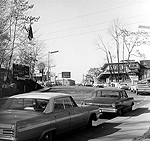
Clifton Hill
an historical view
courtesy of Niagara Falls Public Library
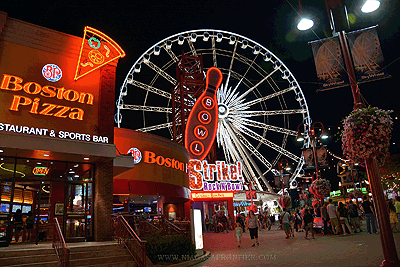
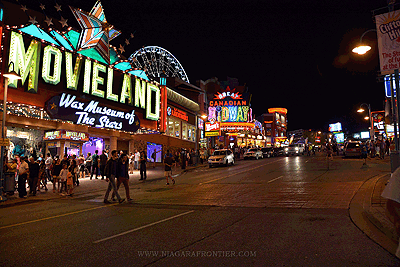
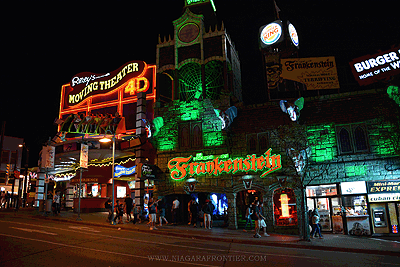
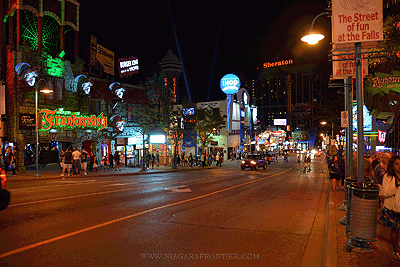
Neon Lights
Of Clifton Hill Tourist District